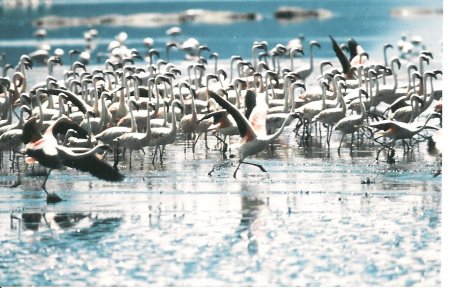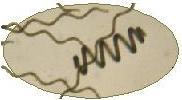|
|
 Where you find hot climate with plenty of
sunlight.
Where there is alkaline water in shalIow lakes stirred by gentle winds. GeneralIy speaking, between 35° north and 35° south latitudes throughout the world. Spirulina, like human beings, does best at 37° Celsius - but can tolerate near freezing and temperatures to around 45°C. Wherever you find the Lesser Flamingo (Phoeniconaias minor, in the Eastern Hemisphere) or the James Flamingo (Phoenicoparrus jamesi, in the Western Hemisphere) you know that the water in which they are feeding contains Spirulina, their principal food.  It is interesting to know that the edges of the beak of the flamingo contain many tiny filter bristles or plateletts. When the bird moves its tongue back and forth, it acts as a pump, bringing water in on the back stroke while the beak is slightly open and pushing the water out through the filtering edges of the beak on the forward thrust. This way the flamingo doesn't swalIow salty water and the Spirulina are trapped inside the beak. As the tongue has a number of backward-pointing spines on its top surface, its pumping action forces the paste of concentrated Spirulina down to the bird's stomach. Nature is very clever.  |
|
It is not suggested to harvest Spirulina
from one of these natural lakes by skimming
the concentrated layer of algae which floats
on top of the water in the early morning;
one doesn't always live near an alkaline
lake, and the Spirulina cultures in natural
lakes can contain less desirable organisms
such as diatoms, flagellates and rotifers,
as weIl as detritus. So most Spirulina farms
consist of artificial basins where the necessary
salts and chemicals are introduced and the
culture conditions can be controlled.
 |
|
Here it is worth noting that Spirulina requires
high alkalinity - a pH of between 8.5 and
11.0, plus it can tolerate large quantities
of sodium chloride salt. Artificial cultures
and the lake cultures generally operate at
about pH 10. This high pH fortunately kills
nearly all organisms pathogenic for humans,
so even the natural lake cultures are safe
to eat.
|
|
However, we would like constant quantity
and quality, longer growing seasons,
and
the ability to control culture
conditions
so as to obtain maximum yields
while consuming
the minimum amount of chemicals,
materials,
and energy. Here the artificial
basins offer
many advantages.
|
|
Artificial basins can be constructed on otherwise
unusable land. lt just has to
be f1at - to
within one or two centimeters
from one end
of the basin to the other. For
smalI basins
this can be done by filling a
plastic tube
or garden hose with water, stretching
it
the length of the basin, and
turning the
two ends skyward. When the water
level at
the two ends is the same, the
two ends are
level. For much bigger basins
one uses a
bulldozer guided by an horizontal
laser beam
intercepted by a censor located
on the bulldozer.
This method is precise to one
centimeter
over a distance of at least one
kilometer.
|

